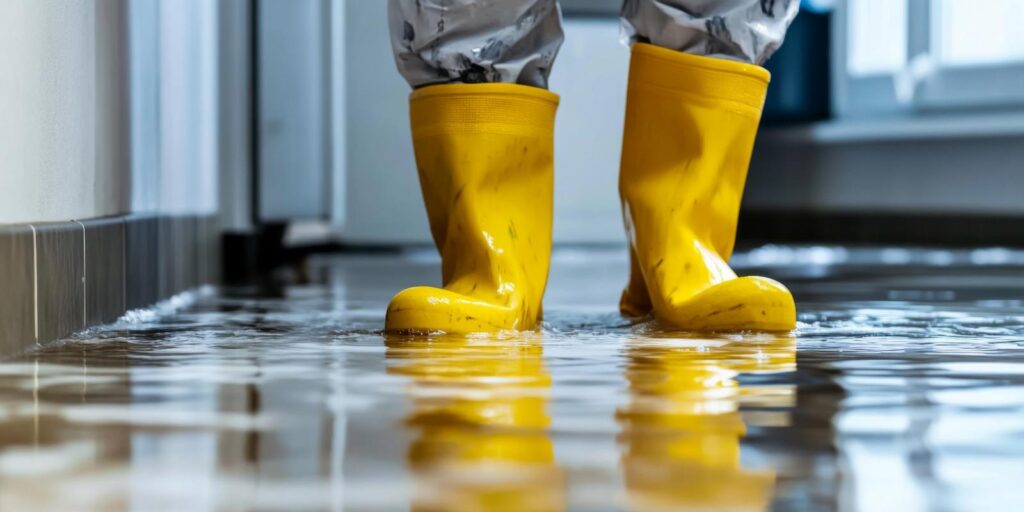
Contents
When faced with water damage, your immediate response is critical to prevent further issues. Start by quickly evaluating the damage and shutting off all utilities to guarantee safety. Once the area is secure, you can efficiently remove standing water and begin the drying process. It is important to clean and sanitize affected surfaces as you go. But what happens next? Understanding the full scope of recovery is fundamental for long-term solutions.
Key Takeaways
- Quickly assess the damage by identifying affected areas, visible signs, and using a moisture meter for hidden moisture detection.
- Shut off utilities immediately, including water, electricity, and gas, to prevent further hazards.
- Remove standing water using a submersible pump or wet-dry vacuum, wearing protective gear during the process.
- Set up dehumidifiers and fans to promote drying, maintaining humidity below 50% to prevent mold growth.
- Clean and sanitize affected surfaces, focusing on high-touch areas, and assess structural integrity for safety.
Assessing the Damage Quickly
How can you effectively assess water damage in your property? Start with a quick evaluation to identify the most affected areas. Look for visible signs like discoloration, bubbling paint, or warped flooring. These indicators can guide your damage assessment.
Use a moisture meter to pinpoint hidden moisture in walls or ceilings; this tool can provide a clear picture of the damage extent.
Next, check for any musty odors, which often reveal hidden mold growth. Don’t forget to inspect your belongings—furniture and personal items may also be affected.
Document your findings with photos and notes, as this information proves invaluable for insurance claims.
Shutting Off Utilities and Water Supply
When facing water damage, your first step is to locate the main shut-off valve and turn off the water supply to prevent further flooding.
Next, you should disable the electricity to avoid electrical hazards, followed by shutting off the gas supply to guarantee safety.
Taking these actions promptly can greatly mitigate the risks associated with water damage.
Locate Main Shut-Off Valve
In any water damage situation, locating the main shut-off valve is essential for quickly mitigating the impact of leaks or flooding. Knowing where to find this valve can save you time, stress, and money.
Here are some valve accessibility tips to help you identify the water source efficiently:
Check the perimeter: Look in basements, crawl spaces, or near exterior walls where pipes enter.
Follow the water line: Trace any visible pipes to locate the shut-off valve.
Ask your neighbors: They may have valuable insights on common locations in your area.
Consult your home’s blueprint: This can provide a clear layout for locating the valve.
Acting swiftly will allow you to maintain control and minimize damage effectively.
Turn Off Electricity
Turning off electricity is vital in any water damage scenario to prevent electrical hazards and further complications.
Start by locating your circuit breaker or fuse box, which is typically found in basements, garages, or utility rooms. Switch off the main breaker to cut power to your entire home.
If you’re uncertain or feel unsafe, don’t hesitate to call a professional. This step is essential for your electrical safety and should be part of your emergency preparedness plan.
After the power is off, you can safely assess the extent of the water damage without the risk of electrical shock.
Disable Gas Supply
Before you start any recovery efforts, disabling the gas supply is vital to prevent potential hazards. A gas leak can lead to dangerous situations, and following safety protocols is imperative.
Here’s what you should do:
- Locate your gas meter, usually found outside your home.
- Turn the valve on the gas line to the OFF position by turning it a quarter turn.
- If you smell gas, evacuate immediately and call emergency services.
- Contact a professional to inspect your system before restoring gas service.
Taking these steps not only safeguards your property but also guarantees the safety of your loved ones.
Together, we can navigate this challenging time and restore your home with confidence.
Removing Standing Water Efficiently
Addressing standing water promptly is vital to prevent further damage and mold growth in affected areas.
Start by gathering necessary tools such as a submersible pump or a wet-dry vacuum for effective standing water removal. If you’re dealing with a significant amount of water, efficient pumping is key. Position the pump at the lowest point to maximize water extraction. Confirm the power source and verify it’s safe to use in wet conditions.
For smaller areas, a wet-dry vacuum can be your best friend; it allows for precise extraction, especially in tight spaces.
Be sure to wear protective gear, including gloves and boots, as you work. After pumping out the majority of water, use towels or mops to soak up any residual moisture. This thorough approach not only speeds up recovery but also fosters a sense of community and support as you tackle the challenge together.
Drying and Dehumidifying Affected Areas
Once you’ve removed standing water, it’s vital to begin drying and dehumidifying the affected areas to prevent further damage and mold growth.
Effective moisture control is fundamental in this process. Here’s how to get started:
Set your dehumidifier settings to the ideal level, typically between 30-50% humidity, to efficiently extract moisture from the air.
Use fans to circulate air and speed up the drying process. Position them strategically for maximum airflow.
Open windows and doors when possible, allowing fresh air to help reduce indoor humidity.
Inspect and monitor moisture levels regularly with a hygrometer to verify your efforts are effective.
Cleaning and Sanitizing Surfaces
As you tackle the aftermath of water damage, cleaning and sanitizing surfaces is essential to eliminate contaminants and prevent health risks.
Start by gathering effective cleaning agents, such as a mixture of warm water and mild detergent or specialized disinfectants. Focus on high-touch areas like countertops, doorknobs, and light switches, ensuring thorough surface sanitation.
Use a clean cloth or sponge, applying the cleaning solution generously to loosen dirt and grime. For porous surfaces, consider deeper scrubbing to remove any trapped contaminants.
After cleaning, rinse surfaces with clean water to eliminate residue, then apply a sanitizing solution to kill remaining pathogens.
Let the surfaces air dry completely to further reduce the risk of bacteria and mold growth.
Inspecting for Mold Growth
Since mold can develop quickly in damp environments, inspecting for its presence should be a top priority after experiencing water damage. Ignoring it can lead to serious health issues and compromised indoor air quality.
To guarantee your space is mold-free, follow these steps:
- Check for visible mold: Look in hidden areas like behind walls, under carpets, and in crawl spaces.
- Smell for musty odors: Unpleasant smells often indicate mold growth, even if you can’t see it.
- Monitor humidity levels: Keep indoor humidity below 60% using dehumidifiers as needed.
- Implement mold prevention strategies: Use mold-resistant materials during repairs to safeguard against future growth.
Taking these measures not only protects your home but also fosters a healthier environment for you and your loved ones.
Prioritize mold inspection to guarantee everyone can breathe easier.
Restoring and Repairing Damaged Structures
When restoring and repairing damaged structures, you need to first assess the structural integrity to guarantee safety.
After that, effective drying and dehumidification methods are essential to prevent further deterioration.
Finally, employing the right repairs and restoration techniques will help you restore the property to its original condition.
Assessing Structural Integrity
To effectively restore and repair structures affected by water damage, evaluating their structural integrity is essential. A thorough structural assessment helps guarantee your home’s building stability and safety.
Here’s how you can approach this critical task:
Inspect for visible damage: Look for cracks, warping, or sagging in walls and ceilings.
Evaluate foundation stability: Check for sinking, shifting, or moisture accumulation around the foundation.
Assess load-bearing elements: Verify beams and columns remain intact and functional.
Consult a professional: Engage a structural engineer for a detailed evaluation.
Taking these steps not only reassures you of your space’s safety but also fosters a sense of belonging in your home.
Prioritizing structural integrity leads to a secure and resilient environment for you and your loved ones.
Drying and Dehumidification
After ensuring the structural integrity of your home, the next step in the recovery process involves effective drying and dehumidification of the affected areas.
Utilize appropriate drying methods, such as air movement and heat application, to facilitate moisture evaporation. Fans and heaters can expedite this process, but don’t overlook the importance of dehumidifiers.
Different dehumidifier types, like refrigerant and desiccant, serve distinct needs; select based on the severity of the water damage and humidity levels. Aim to maintain indoor humidity below 50% to prevent mold growth.
Regularly monitor progress, adjusting equipment as needed to achieve ideal results. With diligent efforts, you’ll restore your home’s comfort and safety, ensuring a welcoming environment once again.
Repairs and Restoration Techniques
While evaluating the extent of water damage, you’ll need to implement targeted repairs and restoration techniques to restore your home effectively.
Start by using proper water extraction methods to eliminate standing water. Next, invest in high-quality restoration equipment like air movers and dehumidifiers to dry out affected areas.
Once everything’s dry, assess structural integrity and make necessary repairs:
- Replace damaged drywall and insulation.
- Repair or replace flooring that’s warped or ruined.
- Treat mold-prone areas with appropriate solutions.
- Check electrical systems for safety and functionality.
To Sum Up
So, you’ve turned your home into a water park—congrats! But before you start charging admission, take a moment to follow these immediate solutions for water damage recovery. Shut off utilities, remove standing water, and dry the area thoroughly. Don’t forget to clean and inspect for mold, because who doesn’t want an unwanted fungus as a housemate? With these steps, you can restore your space and avoid turning your home into a breeding ground for disaster.
Recent Posts
Reliable Guide to Swift Water Damage Recovery
Did you know that nearly 14,000 people experience a water damage emergency every day in
5 Tips for Quick Water Damage Recovery
When faced with water damage, time is of the essence. You need to act quickly
Budget-Friendly Water Damage Recovery Solutions
Many homeowners underestimate the costs associated with water damage recovery, often leading to unnecessary expenses.
